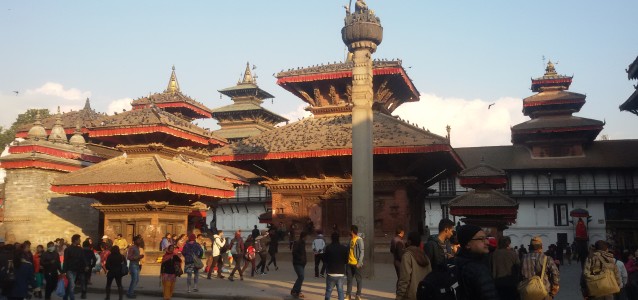Kathmandu, the charming capital city of Nepal, has a number of magical places to visit. Amongst many, cultural heritage monuments of Kathmandu valley have a different but unbelievably beautiful charm to offer to visitors. From the biggest Buddhist shrine in the world to medieval palaces with beautiful art works and amazing architecture; Cheeky monkeys around the oldest monument in Kathmandu valley to the most unique cremation in open funeral ground; all these heritage monuments leave you with an adoringly beautiful experience of your life time. This tour is perfect for cultural, historical and aesthetic immersion. You will be amazed to see the intricate wood, stone, metal craft works in temple and palace buildings. Knowing the number of Hindu gods and goddesses will leave you with your jaws open. This is the only place where you can see a living goddess. You will feel yourself highly spiritual when you come across the Buddhist monks and Hindu Holy men called Sadhus. An emotional feeling will grip you as you watch the final farewell for a Hindu from this world by family members, relatives and friends. You can feel these different but life changing experiences nowhere but only here in Kathmandu.
Must visit places:
1. Durbar Squares:
“Durbar” means palace and these are the palaces from medieval Kathmandu, time spanning from 15th – the mid-18th century. These palaces are undoubtedly the most detailed examples of medieval art, architecture, culture and life style of people in Kathmandu. The finest examples of wooden craft, stone craft, metal craft, and paintings from ancient and medieval period can be seen in these palace areas. There are three different palaces from separate, independent medieval kingdoms in Kathmandu valley.
Bhaktapur Durbar Square:
The oldest of all the durbar squares, Bhaktapur is the oldest existing cities in Kathmandu valley. A well-known place for wooden craft works, pottery and old buildings, Bhaktapur offers a unique tour experience. The whole town of Bhaktapur has been enlisted in the UNESCO’s cultural heritage list giving high value to its unique features.
Patan Durbar Square:
Another medieval palace full of beautiful pagoda temples and palace buildings with intricate wood carving works and some of the finest examples of metal craft work. Patan is also known as the city of fine arts and has the finest metal craft museum in south Asia.
Kathmandu Durbar Square:
A royal palace until late 19th century, this palace square has beautiful temple buildings and the most alluring is the temple of living goddess, Kumari. The Kumari system is a very unique cultural tradition in Kathmandu valley in which a girl is kept in temple as a goddess. You will be able to see her in her temple at certain time of the day.
2. Hindu Temples:
As majority of people in Nepal follow Hinduism, you find temples dedicated to Hindu gods and goddesses everywhere you go in Nepal, especially in Kathmandu as it is also known as city of temples. Out of thousands of temples, two have been enlisted in the UNESCO’s cultural heritage list.
Pashupatinath:
Pashupatinath literally translates as lord of animals. This temple is a very important temple for Hindus living around the world and is dedicated to lord Shiva who is the destroyer in Hinduism. People have belief that if they visit and worship in this temple, they achieve ‘moksha’, the salvation. But the temple is accessible to Hindus only; non-Hindus can’t enter the temple premises. There are funeral platforms for Hindus on the bank of the holy river Bagmati where one can see the dead Hindus being cremated in the open. You see body, wooden pyre, death rituals, fire and the whole unique cremation process.
Changu Narayan:
Changu Narayan temple is the oldest of all the Hindu temples existing in Kathmandu valley and is situated in the eastern part of the valley. The temple is dedicated to lord Vishnu, the protector in Hinduism. The temple premise has beautiful and finest examples of sculpture.
3. Buddhist Temples:
After Hinduism, Buddhism is the most followed religion in Nepal and the founder of Buddhism, Buddha, was born in Lumbini which in the southern part of Nepal. There are lots of Buddhist monasteries and stupas in Kathmandu and two of them are included in the cultural heritage list.
Swoyambhunath:
Swoyambhu literally translates as the self-created and this Buddhist temple site is believed to have been created by itself over 2000 years ago and is the oldest monument in Kathmandu. This temple is famously known as monkey temple amongst tourists as there are lots of monkeys living in this small forested hill. This is also a good vantage point to see Kathmandu valley on a clear day.
Boudhanath:
Boudhanath is the biggest Buddhist Stupa in the world. It is the most important pilgrimage site for people following Tibetan Buddhism. The area is peaceful and enclosed circle, in the middle of which the massive Stupa is situated. The shrine is believed to have been built around 4th or 5th century.
The tour to these heritage monuments in Kathmandu valley gives the best cultural, spiritual, historical and aesthetic experience. The tour can be a perfect starter of the tour of magical Nepal. While you are touring these places, you simply –
• Experience unreal aesthetic pleasure
• Immerse into unique cultural dimension
• See the amazing skills of Nepalese artisans
• Feel an unbelievably pleasant spiritual growth
• Feel the magic of colorful prayer flags
• Contemplate over the unique Hindu death ritual
• Wonder how a girl is given the status of a goddess
And a lot more which add to make your visit to these places more than just awesome.

